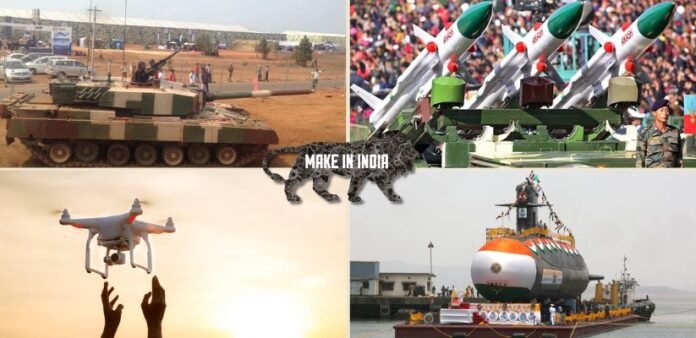India stands at a critical juncture in its pursuit of strategic self-reliance. While the Aatmanirbhar Bharat initiative aims to shift the nation’s defence trajectory, the truth is more ambiguous. Despite policy declarations and assurances, India remains among the world’s largest arms importers. The improvement to reduce imports and enhance exports is on a sound trajectory, but still suboptimal. Beneath the surface of this high-decibel nationalism lies a deeper challenge that goes well beyond assembling foreign technologies on Indian soil. It is a question of genuine capability, homegrown technology and ownership.
The core issue is not a lack of vision. It is the gap between intent and execution, between policy and outcome. India must now rise to the occasion and build, own and scale technologies that are not just made in India but made by India – imagined and mastered here.
Three Obstacles India Must Overcome
The struggle for self-reliance in defence continues to be hampered by three powerful, interconnected constraints. Each one reinforces the other, creating a loop that delays and dilutes the very ambition it seeks to serve.
The first is operational urgency. India faces a complex multi-domain security environment on multiple fronts with both conventional and hybrid threats. The armed forces naturally demand systems that are proven, reliable and quickly deployable. The technological cycle and acquisition cycle are totally out of synch. Present procurement is complex, slow, unwieldy, outdated and misguided by a giant GSQR, which optimises what does not exist rather than what exists. Thus, it is no surprise that foreign acquisitions continue to be prioritised. Time becomes a weapon, and there is no patience for iterative innovation or delayed delivery.
The Arjun Main Battle Tank has yet to meet the operational aspirations and confidence of the Indian Army. The Tejas Light Combat Aircraft took nearly four decades to reach frontline squadrons. The Kaveri jet engine has failed to power any fighter. At the heart of these failures lies a mix of risk-averse leadership, fragmented execution and lack of design authority
The second is industrial behaviour. India’s private sector has enormous potential but remains largely focused on licensed assembly and production. This approach makes commercial sense. It offers predictable timelines and low risk. But it also sidelines original R&D, discourages design innovation and builds little technological depth. Profit and protectionism often win over bold investment.
The third is a legacy of dependence. Public sector units have long relied on Transfer of Technology agreements, which rarely provide access to the actual source codes, design protocols or critical subsystems. India becomes the assembler, not the author, of its defence platforms. Without owning the intellectual core, real sovereignty remains elusive.
From Breakthroughs to Bottlenecks
India’s defence journey is not without moments of pride. Projects like the Integrated Guided Missile Development Programme, launched during an era of global technology denial, delivered missiles such as Agni and Prithvi that remain credible deterrents. The BrahMos cruise missile has set global standards in speed and precision. Indigenous nuclear submarines, like the Arihant-class, have enhanced second-strike capabilities and remain a successful model.
But these remain outliers. The more frequent stories are those of delay, dilution and underachievement. The Arjun Main Battle Tank has yet to meet the operational aspirations and confidence of the Indian Army. The Tejas Light Combat Aircraft took nearly four decades to reach frontline squadrons. The Kaveri jet engine has failed to power any fighter. At the heart of these failures lies a mix of risk-averse leadership, fragmented execution and lack of design authority.
Timelines must be enforced with rigour. Defence projects cannot be open-ended. Without speed, strategic relevance is lost. A dedicated monitoring authority should be empowered to coordinate and fast-track projects from concept to induction. Digital platforms must support collaboration, transparency and real-time problem-solving across ministries, industry and the armed forces
What Global Models Teach Us
Across the world, different nations have found their pathways to self-reliance in defence, shaped by national goals and industrial culture.
The United States has built a powerful innovation ecosystem by aligning defence contracts with private research. Agencies like DARPA do not merely respond to threats; they shape future warfare by betting on radical ideas. American defence firms generate IP, not just products. They are originators, not licensees.
Russia and China have relied on state-led models that enforce continuity and command. China’s rise has been especially aggressive, combining reverse engineering, massive domestic investment and a clear national doctrine to leapfrog into cutting-edge technologies.
Israel offers a compelling example for India. Its defence sector is deeply intertwined with innovation, where firms like Rafael and IAI work hand-in-hand with users and developers. Their success comes not just from export potential but from tightly coupled cycles of feedback, improvisation and iteration.
South Korea has adopted a hybrid model that supports private innovation with strong government direction. By creating structured technology roadmaps and incentivising local design, it has built an ecosystem that is both nimble and nationally aligned.
India must absorb these lessons without copying templates. Our solution must be shaped by our scale, our democracy, our startup potential and our strategic realities.
Some of the platforms used in Op Sindoor were either imported or built using foreign components. Dependence on foreign supply can be fatal in a crisis, especially because no defence partner, no matter how friendly, will share critical technology during its effective cycle. India must wake up to this vulnerability. It has witnessed this repeatedly and received only the second run of technology transfer
A Strategic Realignment for Real Sovereignty
India cannot buy its way to self-reliance. Nor can it achieve autonomy through policies. What is needed is a structural shift that rewards innovation, aligns incentives, acquisition and defence structural reforms, and embeds accountability across every tier of the defence ecosystem.
The Strategic Partnership Model under the current defence acquisition framework must be expanded. The present structure covers only select platforms such as fighter aircraft, Armoured Vehicles and submarines. A broader approach is required. Defence production must follow a layered format. Large integrators should anchor big projects. Medium-sized firms should specialise in subsystems. Startups, research labs and academia must be encouraged to focus on high-risk, high-tech innovation. Only this depth can build resilience.
Timelines must be enforced with rigour. Defence projects cannot be open-ended. Without speed, strategic relevance is lost. A dedicated monitoring authority should be empowered to coordinate and fast-track projects from concept to induction. Digital platforms must support collaboration, transparency and real-time problem-solving across ministries, industry and the armed forces. Further adequate capacities and surge capabilities must be built up and periodically evaluated.
Research and development must be funded with intent by both public and private players. Innovation hubs near universities and DRDO centres must be built as clusters. The user, the technologist, the academia and the manufacturer must be on the same page. Technology grants and tax benefits must foster indigenous core technologies. The shift must be from the indigenisation of foreign products to technologically superior indigenous products. Intellectual property ownership and commercialisation rights must be codified and shared across collaborators. Technology must belong to India, not just be built in India.
Private firms must be given the confidence to invest. Assured long-term contracts, export facilitation and risk-sharing gain-sharing frameworks are essential. Without this, Indian defence firms will never compete with foreign OEMs who come with state backing, global market access and tested product lines.
Infrastructure needs to grow with talent. India must invest not just in manufacturing capacity, but in specialised training programmes for engineers, designers and systems integrators. Without skilled minds, machines are of little use. Without core technology knowledge, labels like Aatmanirbhar are cosmetic.
Compliance-heavy procedures that stifle innovation must be revised. Firms that create technology must be incentivised over those who merely import and integrate. The focus must shift from manufacturing to mastery. This is what will define the future of Indian defence. Further, the lacunae in realistic technology mapping and identifying true indigenous content must be addressed
A Harsh Reality Check
Some of the platforms used in Op Sindoor were either imported or built using foreign components. Even when a system was developed domestically, it often included foreign propulsion, foreign guidance or foreign computing architecture. In a crisis or conflict, this hidden dependence can be fatal. Disruption in global supply due to conflicts or sanctions will impact critical defence capability under operational conditions. This dependency must never happen.
No defence partner, no matter how friendly, will share critical technology during its effective cycle. India must wake up to this vulnerability. It has witnessed this repeatedly and got only the second run of technology transfer.
From Labels to Leadership
The next phase of India’s defence transformation must be driven by ownership, not assembly. From sensors to seekers, from propulsion to software, India must build not just what it uses, but what it upgrades and exports. That is the benchmark of true strategic autonomy.
Procurement must shift from selecting the cheapest product (L1) to choosing the one that offers the best value. Technical (T1) merit, upgradability and indigenisation potential must be weighted alongside cost. Credibility and the ability of the vendor to deliver both in quality and time must also be assessed (Q1). Compliance-heavy procedures that stifle innovation must be revised to favour grabbing opportunities and early adoption.
Firms that create technology must be incentivised over those who merely import and integrate. The focus must shift from manufacturing to mastery. This is what will define the future of Indian defence. Further, the lacunae in realistic technology mapping and identifying true indigenous content must be addressed.
India has a narrow window before the global tech environment becomes more restrictive and polarised. As alliances shift, India must seize the opportunity to secure its future. The equipment induction philosophy must move from ‘threat cum capability’ to ‘capability cum opportunity’. It’s time to move from rhetoric to results, from import dependence to technology leadership. And, the time to act is now
This is the Moment
India has a narrow window before the global tech environment becomes more restrictive and polarised. As alliances shift and denial regimes tighten, India must seize the opportunity to secure its future. The equipment induction philosophy must shift from threat cum capability to capability cum opportunity.
This is not a question of capability. It is a question of courage. Political courage to take hard decisions. Defence budgetary and acquisition reforms. Industrial courage to invest beyond immediate profit. Institutional courage to cut through complexity and deliver outcomes. India needs an integrated defence ecosystem, not just sharks in the sea.
India has done this before. It built missile programmes under sanctions. It developed nuclear submarines in secrecy. It launched missions to the Moon and Mars with limited resources. The challenge before us is not one of imagination; it is one of implementation and political will.
Let this be the decade India moves from ambition to execution, from rhetoric to results, from import dependence to technology leadership. The time to act is not tomorrow, it is now.
The author, a PVSM, AVSM, VSM has had an illustrious career spanning nearly four decades. A distinguished Armoured Corps officer, he has served in various prestigious staff and command appointments including Commander Independent Armoured Brigade, ADG PP, GOC Armoured Division and GOC Strike 1. The officer retired as DG Mechanised Forces in December 2017 during which he was the architect to initiate process for reintroduction of Light Tank and Chairman on the study on C5ISR for Indian Army. Subsequently he was Consultant MoD/OFB from 2018 to 2020. He is also a reputed defence analyst, a motivational speaker and prolific writer on matters of military, defence technology and national security. The views expressed are personal and do not necessarily carry the views of Raksha Anirveda






